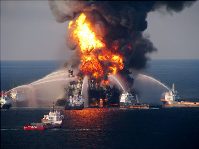BP given brunt of blame in final Gulf oil spill report
 A final investigation report released by US regulators on Wednesday found BP largely at fault in the Deepwater Horizon rig explosion and resulting oil spill in April 2010.
A final investigation report released by US regulators on Wednesday found BP largely at fault in the Deepwater Horizon rig explosion and resulting oil spill in April 2010.
The US Bureau of Ocean Energy Management, Regulation and Enforcement (BOEMRE) and US Coast Guard Joint Investigation Team (JIT) unveiled the final investigative report on the incident.
Their conclusions were as follows:
“The blowout at the Macondo well on April 20, 2010, was the result of a series of decisions that increased risk and a number of actions that failed to fully consider or mitigate those risks,” investigators said.
“While it is not possible to discern which precise combination of these decisions and actions set the blowout in motion, it is clear that increased vigilance and awareness by BP, Transocean and Halliburton personnel at critical junctures during operations at the Macondo well would have reduced the likelihood of the blowout occurring.
BP well designers set the casing in a location that created additional risks of hydrocarbon influx. Even knowing this, BP did not set additional cement ormechanical barriers in the well.
BP made two additional significant decisions that further increased risks – first, it decided to have the Deepwater Horizon crewinstall a lock‐down sleeve as part of the temporary abandonment procedure.
Second, BP decided to use a lost circulation material as spacer, which risked clogging lines used for well integrity tests.
BP personnel and Transocean personnel failed to conduct an accurate negative test to assess the integrity of the production casing cement job. The Deepwater Horizon rig crew, therefore, performed temporary abandonment procedures while unaware of the failed cement job beneath them and the looming influx of hydrocarbons.
Unfortunately, the rig crew then limited its kick detection abilities by deciding to bypass the Sperry Sun flow meter when displacing fluid from the well overboard.
The Deepwater Horizon rig crew missed signs of a kick and thus was delayed in reacting to the well control situation. Once the flow reached the rig floor, the crew closed the upper annular and upper variable bore ram and diverted the flow to the mud gas separator. The mud gas separator could not handle the volume of the blowout and explosions followed.
Additionally, forensic analysis by DNV strongly suggests that by the time a crew member on the bridge activated the emergency disconnect system, the explosions had damaged the Deepwater Horizon’s multiplex cable and hydraulic lines, which rendered inoperable the BOP stack’s blind shear rams.
The force of the blowout, and possibly the force from drill pipe in the riser, buckled the drill pipe and placed it in a position where it could not be completely sheared by the blind shear ram blades. As a result, the blind shear ram, when activated on either April 20 or April 22, could not shear the drill pipe and seal the wellbore.
Flow from the Macondo well continued for 87 days after the blowout, spewing almost 5 million bbl of oil into the Gulf of Mexico."
The panel went on to recommend changes to regulatory requirements and oversight in areas including design (particularly for high flow potential wells), well integrity testing, kick detection and response, rig configuration, blowout preventers, and remotely-operated vehicles.
The final report and panel recommendations can be found here.






Comments